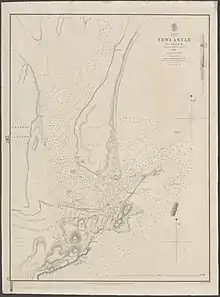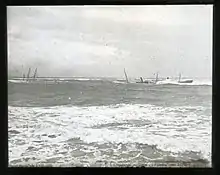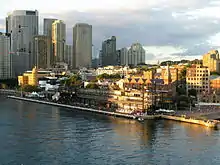Port of Newcastle
The Port of Newcastle is a major seaport in the city of Newcastle, New South Wales, Australia. It is the world's largest coal port.[3]
| Port of Newcastle | |
|---|---|
 A bulk carrier entering Port Hunter, Newcastle | |
Click on the map for a fullscreen view | |
| Location | |
| Country | Australia |
| Location | Newcastle, New South Wales |
| Coordinates | 32°55′S 151°48′E |
| UN/LOCODE | AUNTL[1] |
| Details | |
| Operated by | Port of Newcastle Operations Ltd [2] |
| No. of berths | 20 [2] |
| Draft depth | 16.2 m.[2] |
| Statistics | |
| Website www | |
It is made up of facilities located at Port Hunter - Yohaaba[4] in the Hunter River estuary. The port was the first commercial export port in Australia and is the world's busiest coal export port. Annual exports of coal from Newcastle exceeded A$15 billion in 2012–13. Newcastle berthed more than 2,200 ships a year in 2012–13.[5]
The port's harbourmaster is the Port Authority of New South Wales. Cargo facilities are operated by Port Waratah Coal Services and Newcastle Coal Infrastructure Group at Kooragang Island, as well as other operators at Mayfield, Carrington and Walsh Point. There are plans to build a cruise terminal.
In April 2014 Premier Mike Baird and Treasurer Andrew Constance announced that a "a consortium which comprises Hastings Funds Management and Chinese state-owned China Merchants" had successfully bid $1.75 billion for a 98-year lease of the Port of Newcastle.
History
Pre-colonial history

The Awabakal people were the inhabitants of Newcastle (Muloobinba) living around the harbour and foreshore prior to European contact. Discarded shells of shellfish harvested by local clans for thousands of years formed enormous middens which were burned by Europeans to produce lime for building purposes.[6] The first commercial shipment was recorded in 1799.[7]
Dredging of the harbour began in 1859.[7] In July 2016, Port Hunter was officially dual named Yohaaba, its local Indigenous name.[8]
Shipwrecks
It has been estimated that over 200 vessels have been lost entering or leaving the Port of Newcastle. Vessels have been recorded lost in and around the areas of Port Hunter, Hunter River, Nobbys Head, Stockton Bight, Stockton Beach (Newcastle Beach), Oyster Bank, Williams River and inland Raymond Terrace.[9]
 Shipwreck of the Regent Murray, Newcastle Harbour, NSW, 4 April 1899
Shipwreck of the Regent Murray, Newcastle Harbour, NSW, 4 April 1899 Shipwrecks Regent Murray, Wendouree and Lindus, Newcastle Harbour, NSW, 1899
Shipwrecks Regent Murray, Wendouree and Lindus, Newcastle Harbour, NSW, 1899 Bretagne in Newcastle Harbour, NSW, 1915
Bretagne in Newcastle Harbour, NSW, 1915
See also
- List of ports in Australia
- Port Darwin another port with a 99-year lease with a Chinese company
References
- "UNLOCODE (AU) - AUSTRALIA". service.unece.org. Retrieved 6 January 2022.
- "Port of Newcastle, Australia". www.findaport.com. Shipping Guides Ltd. Retrieved 6 January 2022.
- Kurmelovs, Royce (5 January 2022). "World's largest coal port to be 100% powered by renewable energy". the Guardian. Retrieved 6 January 2022.
- "Media Release, Indigenous Naming Comes To Newcastle" (PDF). Geographical Names Board NSW Government. Archived from the original (PDF) on 4 March 2022. Retrieved 23 July 2022.
- "Annual Report 2012/2013" (PDF). Newcastle Port Corporation. September 2013. Retrieved 10 May 2018.
- "Port of Newcastle: History". Retrieved 17 September 2022. Official website
- "History and Heritage". Port of Newcastle. Retrieved 6 July 2023.
- "Media Release, Indigenous Naming Comes To Newcastle" (PDF). Geographical Names Board NSW Government. Archived from the original (PDF) on 4 March 2022. Retrieved 23 July 2022.
- "Shipwrecks of the Newcastle region including Oyster Bank and the Hunter River". Retrieved 9 October 2020.
